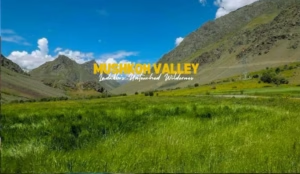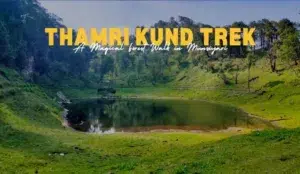“Discover the Hidden Beauty of Kyarkoti Lake 🌄 | Trekking Bliss Awaits! 🏞️ | Explore Nature’s Gem 🥾 #KyarkotiLake”
About Kyarkoti Lake:
- Location: In Taknaur Valley, Kyarkoti Lake is truly found. Harsil, the community closest to Kyarkoti Lake, is 14 kilometers away and may be reached by foot. 25 kilometers before Gangotri, Harsil is situated 75 kilometers from Uttarkashi town. It is simple to travel from Dehradun to Uttarkashi, where one may then take a bus or shared taxi to Harsil.
- Altitude: Situated at an elevation of approximately 4,020 meters (13,188 feet) above sea level, it offers a serene and pristine escape from the bustling world below.
- Natural Beauty: Kyarkoti Lake enchants visitors with its crystal-clear waters, reflecting the surrounding snow-capped peaks, lush meadows, and alpine flora. It is a haven for nature enthusiasts and photographers.
- Glacial Origin: Like many lakes in the region, Kyarkoti Lake owes its existence to glacial activity, as it is fed by the melting ice from the nearby glaciers.
- Trekking Destination: The lake is a popular trekking destination, offering a challenging yet rewarding trek through dense forests, alpine landscapes, and rugged terrain.
- Biodiversity: The surrounding region boasts a rich diversity of flora and fauna, adapted to the high-altitude environment, adding to its ecological significance.
- Spiritual Significance: Kyarkoti Lake is often associated with local myths and legends, making it a place of spiritual importance for the nearby communities.
- Scientific Interest: The lake and its surroundings also draw scientific interest due to their glacial origins, offering insights into geological processes and climate change impact.
History of Kyarkoti Lake:
- Mythological Stories: Kyarkoti Lake finds mention in local myths and legends, with tales of sages and seekers seeking solace and spiritual enlightenment by its tranquil shores.
- Traditional Connections: Over the years, the lake has become a part of traditional treks and pilgrimages for local communities, adding to its cultural and historical significance.
- Scientific Exploration: With the growing interest in the impact of climate change on glaciers and glacial lakes, Kyarkoti Lake has become a subject of scientific study and research.
- Adventure Tourism: Recent years have seen a surge in adventure tourism, attracting trekkers and outdoor enthusiasts from around the world, eager to experience the pristine beauty of Kyarkoti Lake.
- Conservation Efforts: As with many high-altitude ecosystems, Kyarkoti Lake faces conservation challenges. Conservation initiatives are crucial to protect its fragile environment.
Kyarkoti Lake, with its blend of natural grandeur and cultural significance, continues to captivate those who seek adventure, spirituality, and a deeper connection with the Himalayas.
Facts about Kyarkoti Lake:
- Hidden Gem: Kyarkoti Lake is a hidden gem nestled in the Garhwal Himalayas, offering a secluded and pristine natural escape.
- Altitude: Situated at an impressive altitude of approximately 4,020 meters (13,188 feet) above sea level, it ranks among the high-altitude lakes in Uttarakhand, India.
- Glacial Origin: Kyarkoti Lake owes its existence to glacial activity, as it is primarily fed by the melting ice from nearby glaciers, showcasing the geological marvel of the region.
- Natural Beauty: The lake boasts crystal-clear waters that mirror the surrounding snow-capped peaks, lush meadows, and alpine flora, creating a picturesque landscape.
- Trekking Paradise: It is a sought-after destination for trekkers, providing a challenging yet rewarding trek through diverse terrains, including dense forests, alpine landscapes, and rocky paths.
- Biodiversity: The region surrounding Kyarkoti Lake is home to a diverse range of alpine flora and fauna that have adapted to the high-altitude environment, contributing to its ecological significance.
- Mythological Significance: Kyarkoti Lake is often intertwined with local myths and legends, making it a place of spiritual importance and a part of traditional treks and pilgrimages.
- Scientific Interest: The lake’s glacial origins and geological richness make it a subject of scientific study, offering insights into the Earth’s geological processes and the impact of climate change.
- Cultural Heritage: The lake and its surroundings have cultural value, as they are frequently included in traditional treks and pilgrimages for local communities in the Garhwal Himalayas.
- Weather Variability: Due to its high altitude, Kyarkoti Lake experiences rapidly changing weather conditions, and trekkers must be prepared for sudden shifts in climate.
- Remote Location: Its remote setting adds to its charm but necessitates careful planning and preparation for trekkers, ensuring a safe and unforgettable experience.
- Environmental Conservation: Like many high-altitude ecosystems, Kyarkoti Lake faces challenges from climate change and tourism impact. Conservation efforts are vital to preserve its pristine nature.
Kyarkoti Lake’s unique blend of natural beauty, cultural significance, and scientific interest makes it a destination worth exploring for those seeking adventure and a deeper connection with the Himalayas.
Why Kyarkoti Lake is Famous:
- Untouched Beauty: Kyarkoti Lake is famous for its unspoiled natural beauty, with its pristine emerald waters reflecting the majestic Himalayan peaks, creating a serene and picturesque setting.
- High-Altitude Marvel: Its impressive altitude, situated at approximately 4,020 meters (13,188 feet) above sea level, adds to its fame as one of the remarkable high-altitude lakes in the Garhwal Himalayas.
- Challenging Trek: The lake’s popularity stems from the challenging yet rewarding trek it offers, attracting trekkers and adventure enthusiasts eager to conquer its rugged terrain and alpine landscapes.
- Spiritual Significance: Kyarkoti Lake holds spiritual significance and is often associated with local myths and legends. It serves as a place for meditation and reflection, drawing seekers and pilgrims.
- Cultural Heritage: It is an integral part of traditional treks and pilgrimages for local communities, reflecting its cultural value and historical importance in the region.
- Scientific Interest: Kyarkoti Lake’s glacial origin and geological richness captivate researchers, contributing to our understanding of Earth’s geological processes and the impact of climate change.
Things to Do in Kyarkoti Lake:
- Trekking Adventures: The primary activity is trekking to Kyarkoti Lake. The trek takes you through dense forests, alpine meadows, and rocky terrains, offering stunning vistas along the way.
- Photography: Capture the breathtaking landscapes, the mirror-like lake, and the surrounding Himalayan peaks, creating lasting memories of your journey.
- Bird Watching: The region is home to various bird species adapted to high altitudes. Birdwatchers can spot Himalayan species in their natural habitat.
- Botanical Exploration: Explore the diverse alpine flora in the region, including vibrant wildflowers that bloom during the summer months.
- Stargazing: Due to its remote location, Kyarkoti Lake provides an excellent opportunity for stargazing. Clear night skies offer a chance to witness celestial beauty.
- Camping: Experience the tranquility of the Himalayas by camping near the lake. Camping under the starry sky is a memorable experience.
- Local Interactions: Interact with the local communities to learn about their culture, traditions, and the spiritual significance of Kyarkoti Lake.
- Environmental Conservation: Be mindful of the fragile ecosystem. Follow Leave No Trace principles and support local conservation efforts.
- Solo Reflection: For those seeking solitude and self-reflection, Kyarkoti Lake’s tranquil surroundings provide the perfect setting.
- Responsible Tourism: As you explore, practice responsible tourism by minimizing your impact on the environment and respecting the local culture.
Kyarkoti Lake offers a unique blend of natural beauty, cultural significance, and scientific interest, making it a destination of choice for diverse travelers and explorers.
Things to Know about Kyarkoti Lake:
- Location: Kyarkoti Lake is situated in the Uttarkashi district of Uttarakhand, India, within the Garhwal Himalayas, offering a serene and secluded escape.
- Elevation: The lake is perched at an impressive altitude of around 4,020 meters (13,188 feet) above sea level, making it one of the high-altitude gems of the region.
- Glacial Origin: Like many Himalayan lakes, Kyarkoti Lake owes its existence to glacial activity. It is primarily fed by the melting ice from the neighboring glaciers.
- Natural Beauty: The lake is renowned for its crystal-clear waters, reflecting the snow-capped peaks, lush meadows, and alpine flora that surround it, creating a picturesque landscape.
- Trekking Destination: Kyarkoti Lake is a popular trekking destination, offering a challenging yet rewarding trek through diverse terrains, including dense forests, alpine landscapes, and rocky paths.
- Biodiversity: The region around the lake boasts a rich diversity of alpine flora and fauna, adapted to the high-altitude environment, contributing to its ecological significance.
- Spiritual Significance: Kyarkoti Lake holds spiritual importance and is often associated with local myths and legends. It serves as a place for meditation and reflection.
- Scientific Interest: Due to its glacial origins and geological richness, the lake attracts scientific interest, offering insights into Earth’s geological processes and climate change impact.
How to Reach Kyarkoti Lake:
- By Air: The nearest airport is Jolly Grant Airport in Dehradun, Uttarakhand, which is well-connected to major Indian cities. From Dehradun, hire a taxi or take a bus to reach the base point of the trek.
- By Train: Rishikesh and Haridwar are the nearest major railway stations, connected to various cities across India. From these towns, proceed by road to the town of Uttarkashi.
- By Road: Drive or take a bus from major cities like Dehradun, Rishikesh, or Haridwar to Uttarkashi. This town serves as the base for the trek to Kyarkoti Lake.
- Trekking Route: The trek to Kyarkoti Lake typically starts from the town of Uttarkashi and includes trails through dense forests, alpine meadows, and rocky terrain. Local guides are recommended for safety.
- Trekking Permits: Ensure you obtain the necessary trekking permits from the forest department or local authorities in Uttarkashi before beginning the trek, as it passes through sensitive ecological zones.
- Best Time to Visit: The ideal time to visit Kyarkoti Lake is during the summer months, from May to June and September to October, when the weather is relatively stable, and the trekking conditions are favorable.
- Preparation: Given the challenging terrain and high altitude, it’s essential to prepare with appropriate trekking gear, physical fitness, and acclimatization to ensure a safe and enjoyable trek.
- Accommodation: Limited accommodations are available in nearby villages, but camping is a popular choice for trekkers. Plan your stay accordingly.
Reaching Kyarkoti Lake involves a combination of air, train, and road travel, followed by a trek through some of the most stunning landscapes in the Himalayas. Careful planning and preparation are essential to make the most of this unique adventure.
Travel Tips for Kyarkoti Lake:
- Physical Fitness: Prepare yourself physically before embarking on the trek to Kyarkoti Lake. The trek involves challenging terrains and high altitudes, so cardio and strength training can help.
- Acclimatization: Spend at least a day acclimatizing at lower altitudes, such as Uttarkashi, to minimize the risk of altitude sickness during the trek.
- Local Guide: Hire a local guide who knows the trekking route, changing weather patterns, and the region’s flora and fauna. They can ensure a safer and more enriching experience.
- Proper Gear: Invest in quality trekking gear, including appropriate clothing, trekking shoes, a backpack, sleeping bags, and trekking poles, to stay comfortable and safe during the journey.
- Hydration: Stay well-hydrated throughout the trek by carrying a reusable water bottle and purification tablets, as clean water sources may be limited along the way.
- Packed Meals: Given the remote nature of the trek, it’s advisable to carry packed meals or snacks. Prepare sandwiches, energy bars, and pack dry fruits for sustenance during the journey.
- Local Interactions: Respect the local culture and customs. Interact with the local communities along the trekking route, learning about their traditions and values.
- Trekking Permits: Ensure you have obtained the necessary trekking permits and documentation from local authorities in Uttarkashi before starting the trek.
Best Time to Visit Kyarkoti Lake:
- Late Spring to Early Summer (May-June): This period offers the best weather conditions with clear skies and comfortable temperatures, making it ideal for trekking and sightseeing.
- Post-Monsoon (September-October): After the monsoon season, the weather stabilizes, and the landscape becomes lush and vibrant. This is another excellent time to visit.
- Winter (November-April): Kyarkoti Lake is accessible during winter, but extreme cold and heavy snowfall make it challenging. Only experienced trekkers should consider this season.
- Monsoon Season (July-August): Monsoon rains can make the terrain slippery and unsafe for trekking. It’s advisable to avoid Kyarkoti Lake during this time.
- Wildflower Blooms: If you’re interested in wildflowers, visit in late spring or early summer when the meadows around the lake burst into colorful blooms.
- Wildlife Sightings: Late summer and early autumn are also good for spotting wildlife as many animals become more active during this time.
Choosing the best time to visit Kyarkoti Lake depends on your preferences, but planning during the recommended seasons will enhance your overall experience and safety during the journey.
Places to Eat Near Kyarkoti Lake:
- Local Eateries in Uttarkashi: Before embarking on your trek to Kyarkoti Lake, explore the town of Uttarkashi, where you can find local eateries serving North Indian cuisine. Try regional dishes to get a taste of local flavors.
- Pack Your Own Meals: Given the remote and high-altitude location of Kyarkoti Lake, it’s advisable to carry packed meals or snacks. Prepare sandwiches, energy bars, and pack dry fruits for sustenance during the trek.
- Camping Cooking: If you’re camping near Kyarkoti Lake, consider bringing portable camping stoves or equipment to prepare your meals. Cooking amidst the Himalayan wilderness can be an unforgettable experience.
- Local Villages: Along the trekking route, you may come across local villages where you can interact with residents. On occasion, you may request simple meals or tea, offering a unique experience of local hospitality.
Nearby Places to Kyarkoti Lake:
- Uttarkashi: The town of Uttarkashi serves as the base for the Kyarkoti Lake trek. Explore its temples, markets, and local culture before and after your trek.
- Nachiketa Tal: Located near Uttarkashi, this serene lake is surrounded by lush forests and offers a peaceful ambiance for nature lovers.
- Dayara Bugyal: A high-altitude meadow near Uttarkashi, Dayara Bugyal is known for its stunning landscapes and is accessible through trekking.
- Gangotri: A significant pilgrimage destination, Gangotri is a few hours’ drive from Uttarkashi. Visit the Gangotri Temple and enjoy the scenic beauty of the Bhagirathi River.
- Harshil: A picturesque village on the banks of the Bhagirathi River, Harshil is known for its apple orchards and offers a serene environment for relaxation.
- Gangnani: A hot spring destination, Gangnani is a great place to unwind and take a dip in the natural thermal pools.
- Gomukh: The source of the Ganges River, Gomukh is a significant trekking destination for those seeking a spiritual and adventurous journey.
- Gangotri National Park: This protected area surrounding Gangotri is rich in biodiversity and offers trekking routes for nature enthusiasts.
Exploring these nearby places allows you to immerse yourself in the natural and cultural richness of the Uttarkashi region, enhancing your overall experience around Kyarkoti Lake.
Conclusion:
In conclusion, Kyarkoti Lake stands as a pristine jewel nestled in the Garhwal Himalayas, beckoning adventurers and nature enthusiasts to experience its breathtaking beauty, rich cultural heritage, and scientific significance. This high-altitude glacial lake, situated in Uttarakhand, India, offers an unparalleled escape into the heart of the Himalayas.
Kyarkoti Lake’s allure lies in its untouched natural splendor, boasting crystal-clear waters mirroring the snow-capped peaks, lush meadows, and alpine flora that envelop it. It stands as a testament to the raw, unspoiled beauty of the Himalayan region.
Beyond its aesthetic appeal, Kyarkoti Lake holds spiritual significance, woven into local myths and legends, and plays a role in traditional treks and pilgrimages for nearby communities. It also attracts scientific interest due to its glacial origins, contributing to our understanding of Earth’s geological processes.
As visitors venture on the challenging trek to Kyarkoti Lake, they not only embrace adventure but also immerse themselves in an ecosystem teeming with biodiversity, adapted to the high-altitude environment. Responsible tourism and conservation efforts are imperative to preserve this natural wonder for generations to come.
FAQs (Frequently Asked Questions):
1. Is Kyarkoti Lake suitable for beginners in trekking?
- Kyarkoti Lake’s challenging terrain makes it better suited for experienced trekkers. Prior trekking experience is advisable.
2. What is the best time to visit Kyarkoti Lake?
- The ideal times to visit are late spring to early summer (May-June) and post-monsoon (September-October) when the weather is stable. Winter visits are possible but challenging.
3. How do I reach Kyarkoti Lake?
- Reach Uttarkashi by air, train, or road, and then start the trek to Kyarkoti Lake. Trekking permits are required and should be obtained beforehand.
4. Are accommodations available near Kyarkoti Lake?
- Accommodations are limited, especially near the lake. Trekkers often camp. In Uttarkashi and nearby towns, you’ll find a range of hotels and guesthouses.
5. How can I contribute to the conservation of Kyarkoti Lake’s ecosystem?
- To contribute to conservation, practice responsible tourism, minimize environmental impact, and support local initiatives focused on preserving the fragile ecosystem of the region.





